
A head start for our future farmers
Growing Future Farmers is New Zealand’s largest farmer-led vocational workforce
training programme
Page 2
Building sector support for wool
Wool Impact aims to rebuild New Zealand’s global reputation as the world’s best wool producer
Page 6
Issue 10 | 2024




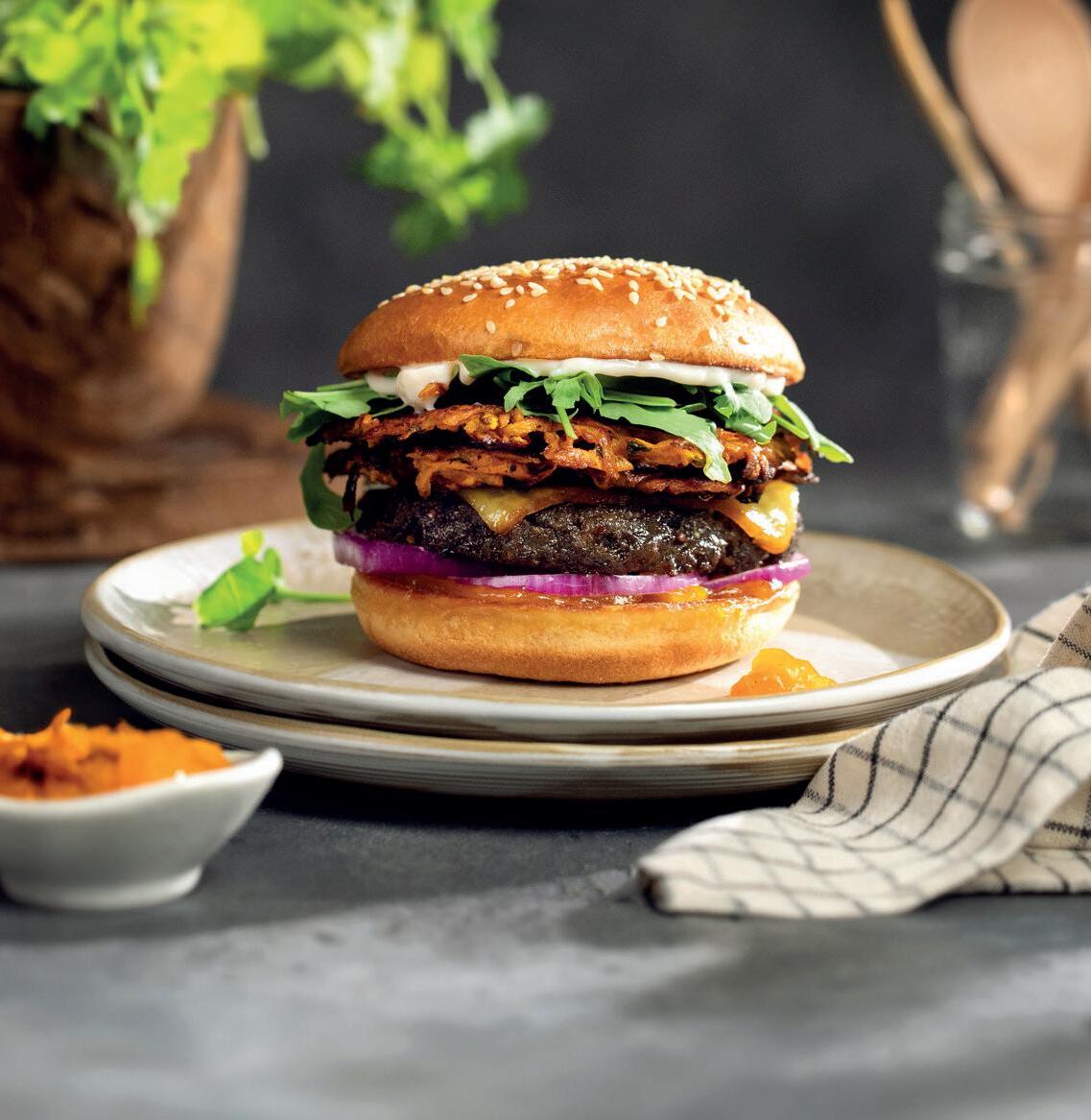




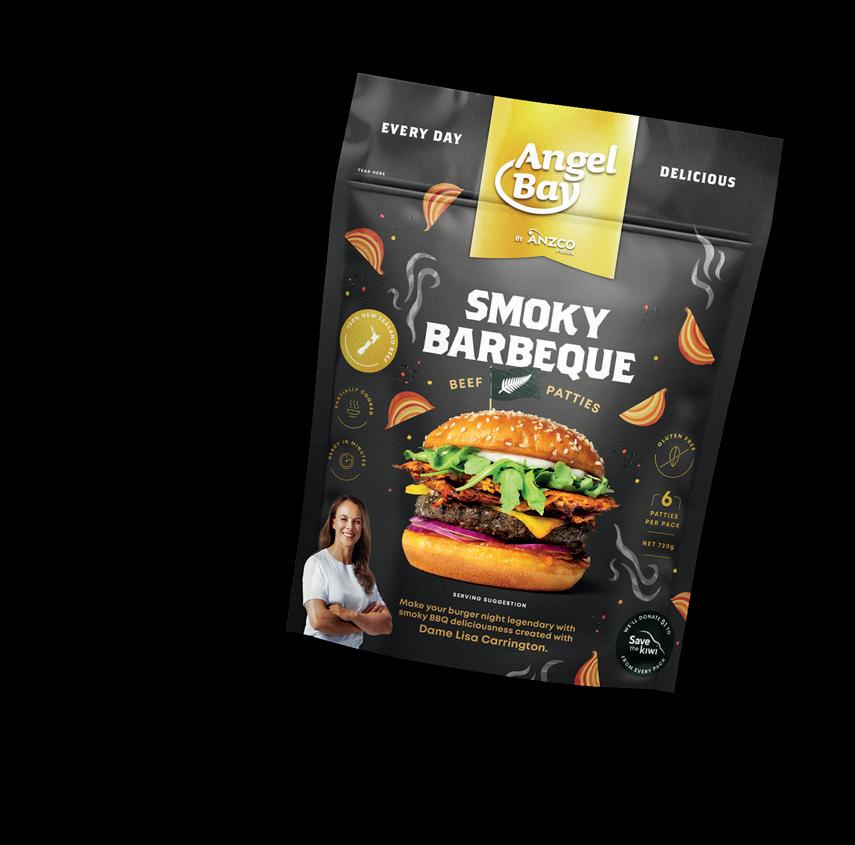
LIMITED EDITION ANGEL BAY SMOKY BARBEQUE. Make Your Burger Night Legendary Available in all good supermarkets from mid-May every day delicious
Welcome
Sometimes it helps to take a step away from what we’re doing to see that the grass isn’t greener on the other side.
In May I spent a couple of weeks travelling around the States researching new ideas and developments mainly related to our Five Star Beef operation.
With grain-fed being by far and away the main farming system in the USA, there are some fantastic new technologies being developed in the feedlot space. However, seeing what others are doing reinforced to me how good our grass-fed system is at delivering taste, nutrition and good health to the world – efficiently and effectively.
This issue of Advantage features stories about two public-private partnerships that are supporting our industry.
The first is AgriZeroNZ , with agriculture in New Zealand contributing to half the country’s greenhouse gas emissions, it’s great to see the progress this joint venture is making with tools to help us reduce this impact. In the US’s predominately grain-fed systems, methane-reducing solutions can be managed more easily through feed additives. AgriZeroNZ is focused on what can be done in our unique New Zealand farming environment, including low emissions pasture and vaccine research. You can read more about these investments on page 14.
Wool is another thing we do well in New Zealand that has been undervalued. Wool Impact is a industry-public venture investing in ways we can rebuild our global reputation as the world’s best wool producer and increase demand for our wool products. There’s more about Wool Impact’s work on page 6. Wool and methane reduction are non-competitive spaces and it’s great to see industry working together to help farmers come up with solutions that are relevant and meaningful to our farming systems and environment, so we can maintain and build the profitability and viability of our sector.
Kind regards,
 GRANT BUNTING
General Manager Systems and Supply, ANZCO Foods
GRANT BUNTING
General Manager Systems and Supply, ANZCO Foods

2 A HEAD START FOR OUR FUTURE FARMERS
Growing Future Farmers is New Zealand’s largest farmer-led vocational workforce training programme.
6 BUILDING SECTOR SUPPORT FOR WOOL
Wool Impact aims to rebuild New Zealand’s global reputation as the world’s best wool producer.
8 ADVANTAGE REWARDS
Take advantage of your rewards points and get some winter gear.
10 GLOBAL MARKET UPDATE
Reviewing the first quarter of 2024.
13 MEET OUR REPS
Introducing James and William.
14 NEW INVESTMENTS TO REDUCE METHANE EMISSIONS
New investments to fast-track emissions reduction with AgriZeroNZ
16 THE LATEST FROM ANZCO FOODS
What we've been up to around the business.
18 ENDURANCE, RESILIENCE AND LIFE-BALANCE
ANZCO Foods' supplier Kieran Hickman talks about balancing life with ANZCO Foods IRONMAN®
20 SUPPORTING OUR COMMUNITIES
Our recent community support and involvement.
Contents
1 WELCOME TO ADVANTAGE
A head start for our future farmers
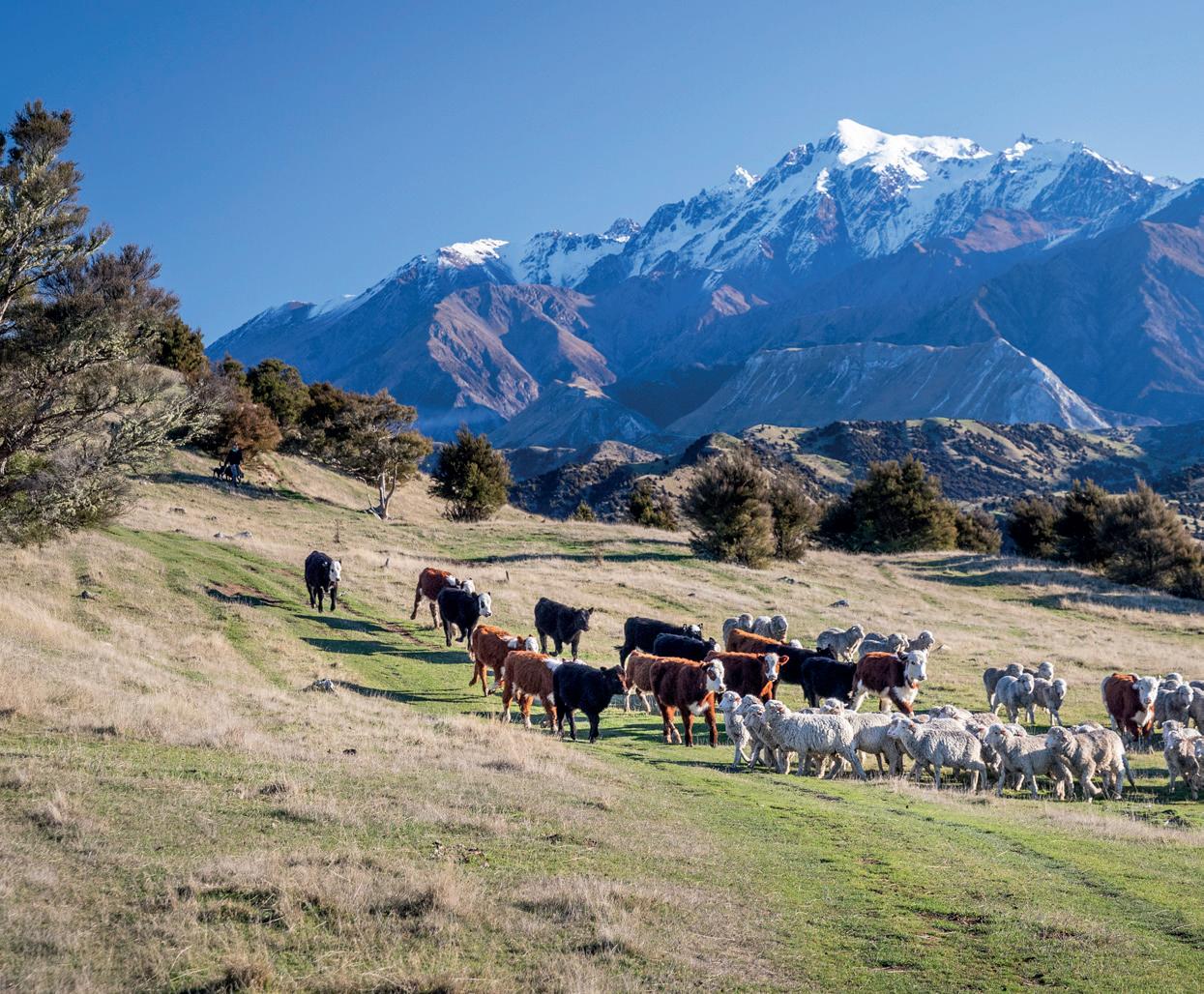
Growing Future Farmers (GFF) is New Zealand’s largest farmer-led vocational workforce training programme and ANZCO Foods is supporting three GFF students on South Island farms.
GFF is an intensive, two-year, highly practical on-farm scholarship programme for youth aged between 16 and 20. Students are supported by industry experts and GFF liaison managers in 14 regions across New Zealand. Their kaupapa is simple: training “by farmers, for farmers”.
Students live and train on-farm and the scholarship covers course fees, access to subsidised gear, equipment and a clothing pack, and pups to train and work with. The programme runs for 44 weeks a year and one day a week is spent off farm attending relevant
courses. Students can earn level 3 NZQA qualifications.
Each participating farm provides a monthly donation to the GFF Trust, which administers weekly payments to students. It is possible to share a student with more than one property.
Marlborough’s Hamish Murray has a GFF student on-farm and encourages other farmers to become involved (see story on adjacent page).
For more information and to apply to be a farm trainer, go to: www.growingfuturefarmers.co.nz/ farm-trainer-application
FUTURE FARMERS 2 Advantage | June 2024
“Everyone is asked for their opinion on key decisions and we value their input. It means staff take pride and responsibility for the environment they work in, in their training and are invested in the farm.”
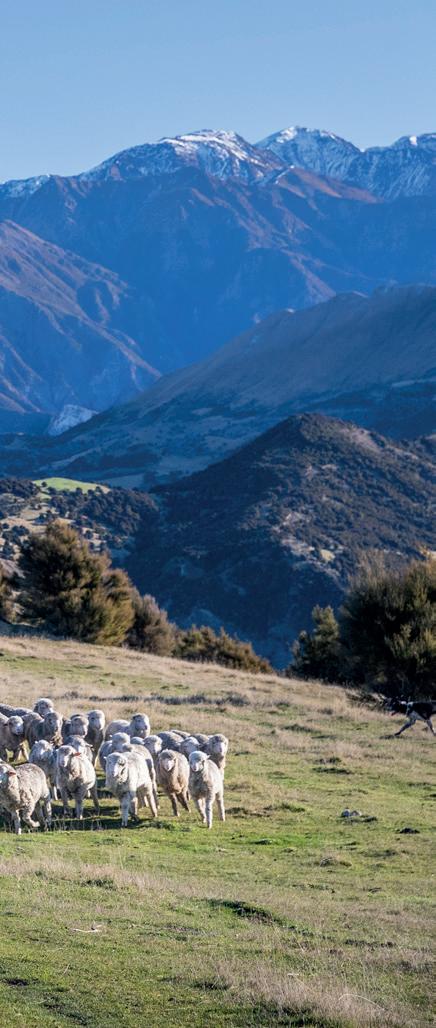
"SHARE, ENJOY, GROW" - A STORY FROM BLUFF STATION
Bluff Station between Blenheim and Kaikoura, inland from Kēkerengū, is a high-country sheep and beef farm.
It’s been in the Murray family for more than a hundred years – steep and rocky land covering 13,000 hectares, half effective, and it stretches back into the Clarence Valley and to the base of Tapuae-o-Uenuki, the highest peak in the Kaikōura Ranges. It’s 35km from the coast to the back boundary.
Hamish Murray runs the farm with his wife Jess and their three children, and his Mum and Dad still work the farm too. They employ three shepherds, two beekeepers and their Growing Future Farmers (GFF) student Tyla Shanks.
Hamish says taking on a GFF student was a no-brainer. “There are fewer and fewer farmers’ kids coming through the ranks and labour for the agriculture industry is getting harder to come by, so GFF is providing a pathway for students to learn and to see if farming is the career for them.”
He likes the fact the students are “green” with very little farming knowledge or experience and says the GFF programme provides a fantastic foundation of essential farming skills.
Tyla fits in with the farm’s vision of "Share, Enjoy and Grow". “We make that the basis of any decision making,” Hamish says.
“Share means sharing resources and knowledge around the valley right through to ensuring any visitors to the farm are given products, whether it’s a leg of lamb or a jar of honey.”
Enjoy is about being present in the moment. “On-farm there are always shitty jobs to do, but there are also
great ones and we encourage each other to enjoy it all. If you’re out on the farm and see a great view, then stop and take a photo. We strive to enjoy every day.”
Grow is about growing quality products, seeing and seizing opportunities. “All these things are anchors in what we stand for and our future.”
Bluff Station farms 6,500 Merino ewes, between 950 and 1,000 Hereford beef cattle and 800 beehives.
Hamish says while isolation is probably their biggest challenge – in the 2014-15 drought they had to move stock to 15 farms from Havelock to Pleasant Point – they haven’t made many major changes to the farm or their approach to farming; the biggest change has been to ensure buy-in from all staff.
“Everyone is asked for their opinion on key decisions and we value their input. It means staff take pride and responsibility for the environment they work in, in their training and are invested in the farm.” And Hamish says by creating opportunities for young people it helps to raise the bar with respect to culture, health and safety and improvement on-farm.
No question is a silly question, he says, and that includes any question GFF student Tyla might ask. “Often those questions make us reconsider how something might have been done in the past and make us question whether it’s the right way for the future.
“Farmers can’t complain about the future if they’re not investing in it or doing something about it. That’s why I’d encourage any farmer who has the ability to take on a student to do so.”
 Above:
Bluff Station - the high country sheep and beef farm. Right: Hamish and Jess Murray.
Above:
Bluff Station - the high country sheep and beef farm. Right: Hamish and Jess Murray.
Meet the 'Growing Future Farmers' students

Tyla Shanks, former city girl, is now working on Bluff Station in Marlborough.
Tyla (Ngāi Tahu) grew up in Christchurch but spent great holidays in Southland on her grandparents’ sheep and beef farm in the Catlins.
Despite being shown other career opportunities, Tyla was pretty sure she wanted to farm. She was in year 12 at Papanui High School when she learned about the GFF programme at a school careers’ evening. She completed year 13 and applied to join the GFF. In January this year she arrived at Bluff Station.
She’s learned a lot in a short time: about mustering, high country farming, working with cattle, body condition scoring, pregnancy scanning cows, weaning calves and lambs, and training her own heading pup, which she says has been the highlight.
Students get their own pup as part of the programme and attend dog training and obedience classes. Once trained, they put commands into practice by taking their pup around the farm with training sheep.
The stock manager and shepherds at Bluff Station help Tyla when she’s practising. “My favourite thing is mustering, and I’m looking forward to when I can take my newly trained pup with me to get the job done. At the moment I still need guidance,” she says.
Tyla’s day usually starts at 6:30am to be ready for work an hour later. The team gets together and makes a plan for the day – who’s doing what and where – and the day normally finishes about 5:00pm.
Sometimes she’ll have homework to complete as part of the GFF programme, otherwise she’ll socialise with the other shepherds or catch up with friends.
Her experiences on her grandparents’ farm and now at Bluff Station have reinforced her desire to have a lifetime career in farming. “I’d like to become a stock manager and ultimately take over my grandparents farm in the Catlins,” she says.

“I’d like to become a stock manager and ultimately take over my grandparents farm in the Catlins,” she says.
FUTURE FARMERS 4 Advantage | June 2024
“There’s nothing better than being out on farm on a good day with the sunshine and fresh air. It’s good for the health – mental and physical.”
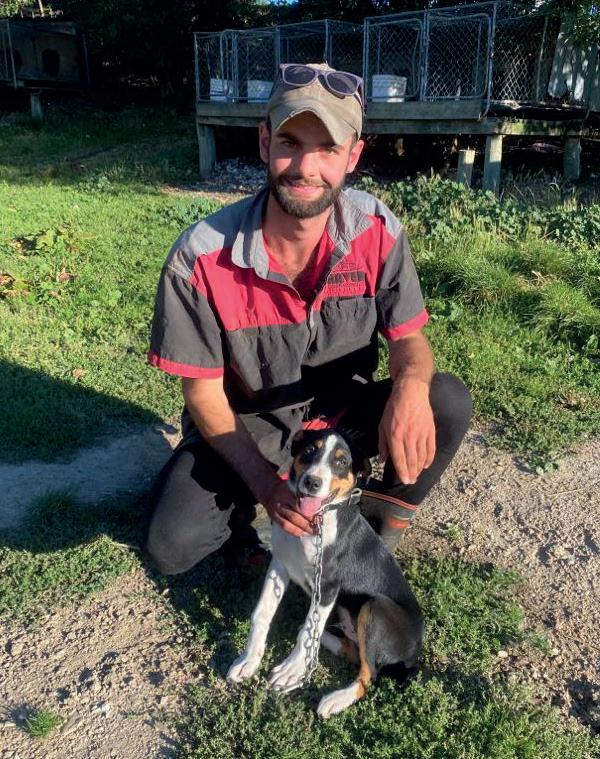
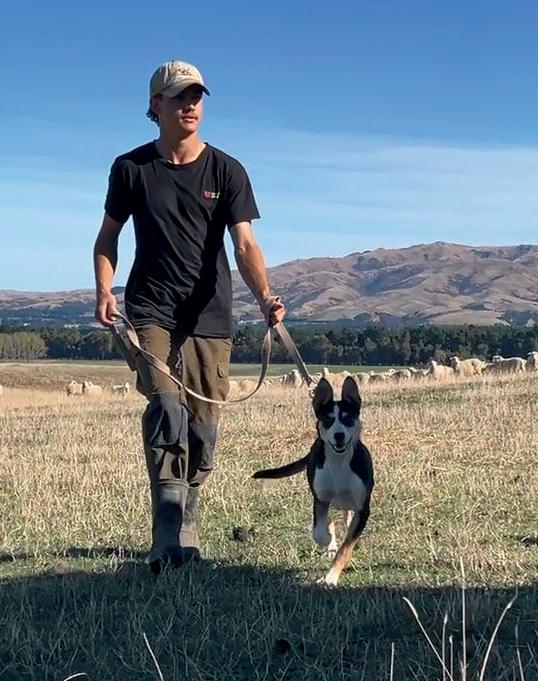
Oliver Grayling is mad about horses – grooming and competing, but he’s keen to learn the ‘why’ behind farming and farming systems.
He can be found at 28,000ha Beaumont Station in Otago. It lies between the Clutha River in the southwest and the Taieri River in the northeast. At Beaumont he’s in his element.
The Hore family has been farming and breeding horses for more than five generations and has lived at Beaumont Station for 44 years. The primary use for horses has been for farm work; horses are still used for mustering on the station. In recent years Beaumont has also been producing sport horses.
Oliver sees the GFF programme as a mechanism to get practical skills and work in an environment that will expose him to the many and varied aspects of farming. Long-term he’d like to be a farm manager and plans to continue his studies beyond the two-year GFF programme.
When he’s not working on-farm you’ll find him doing something else outdoors. Maybe fishing, or diving, fourwheel driving, grooming and riding horses, or clay target shooting.
Seth Judge, self-confessed townie from Nelson, is based at Mendip Farm in Cheviot. Like many city kids, he was a regular on his uncle’s farm during school holidays and weekends, and that stirred his interest to pick it up as a career.
He likes animals and the farming sector and aspires to work his way up to becoming a block manager or perhaps even managing a station one day.
“There’s nothing better than being out on farm on a good day with the sunshine and fresh air. It’s good for the health – mental and physical.”
Seth says he’s learned so much on the programme already. He likes the variety farming brings – no two jobs are the same and there are so many different things to be done throughout the year.
Like Tyla in Marlborough, Seth’s loved getting his own pup and being able to train it himself. “That’s been really rewarding.”
He says the GFF programme has been excellent so far. “It’s given me a really good head-start and shown me what happens out on farm on a day-to-day basis.”
5
Building sector support for wool
New Zealand’s strong wool growers consistently produce some of the best wool in the world, but they are largely disconnected from the local and international brands that use their fibre.
Wool Impact, formed mid-2022, is a partnership between the New Zealand government, contributing $4.5 million through its Sustainable Food and Fibre Futures Fund, alongside WoolWorks and the sheep sector – including ANZCO Foods. Wool Impact aims to rebuild New Zealand’s global reputation as the world’s best wool producer, grow demand and restore profitability to strong wool growers.
The time is right for wool as a solution for consumers aspiring to a more sustainable life. It does not contribute to microplastic pollution, it absorbs indoor air pollutants contributing to the wellbeing of a generation that spends 90% of time indoors, and products made of wool have enduring beauty and performance. So, what is it going to take for these benefits to translate to value for wool growers?
For Wool Impact it starts with building demand. We do this by supporting the growth of existing wool brands, making it easier for innovators to use wool, and supporting brands to make a switch to New Zealand wool from synthetics.
To build demand we need good evidence of wool’s ability to solve problems for people and the planet. A reliance on “natural and renewable” is no longer sufficient for global brands in the face of disclosure legislation,
corporate reporting expectations, and green building standards.
Demand alone is not going to fix things. To improve returns to growers we need more direct sales pathways based around the valuable attributes of our wool and farm systems. These forge a closer connection between brands and growers and maintain the integrity of differentiated fibre stories beyond fibre qualities. The auction system of today does not provide for this.
Underpinning this is the fundamental need for sector leadership and capability; coordination within the sector to improve impact and reduce duplication, an impactful story for wool, capability building, data and advocacy. Wool Impact has a strategic partnership with Campaign for Wool to this effect, and you will see more of this type of alignment.
Our ultimate measure of success will be an increase in the farmgate price of strong wool. We supported the development of the Strong Wool Indicator Fusca that gives growers an independent and representative price indicator and allows us to monitor progress with improving returns.
We are grateful for the support of the ANZCO Foods' community and encourage you to follow our progress. Sign up for Wool Impact news here: woolimpact.com/sign-up/
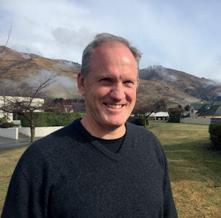
ANDY CAUGHEY Chief Executive, Wool Impact
"Wool Impact aims to rebuild New Zealand’s global reputation as the world’s best wool producer, grow demand and restore profitability to strong wool growers."
6 Advantage | June 2024 INDUSTRY

HORIZONS OF DEMAND
Signals from global architecture and design (A&D) agencies suggest that if wool’s functional and environmental performance is well evidenced, wool should be a fibre of choice. This is also echoed by the New Zealand Government’s commitment to the specification of wool in government tenders.
If the predictions of domestic brands using wool in their product ranges are realised, there could be a shift from about 15% of New Zealand’s annual production of 100,000 tonne of greasy wool used domestically to about 35%.
Wool Impact is seeing three distinct horizons of demand.
1. Current uses for wool; carpet, area rugs, fabrics and insulation. These have high volume, high growth potential in the near term.
2. When it comes to diversified use of fibre, brands like FLOC, Big Save, Kindface, Honest Wolf, Wisewool, Woolkin, Foxtrot Homes, Lanaco and Woolchemy are leading the innovation pathway by transforming strong wool into products from acoustic panels to bedding, bags, personal care and filtration products.
3. Beyond fibre, wool biomaterials are forming a new horizon of demand via Wool Research Organisation of New Zealand’s investment. WoolSource is marketing the deconstructed wool fibre into new markets for particles, powders and pigments that can be used in skin care, printer inks and dyes for garment printing, displacing the current petrochemical ingredients.
NEW NAVIGATOR SUPPORTS WOOL INNOVATORS
There is no shortage of innovators and entrepreneurs with passion and ideas for wool, but they often lack adequate support to bring their ideas to fruition, and at speed.
Earlier this year, after reviewing the wool innovation ecosystem, Wool Impact appointed a dedicated ‘navigator’ to facilitate connections and support brands and individuals to negotiate the complexities of the innovation journey.
Anna Crosbie, who has taken on the navigator role, has a wealth of experience helping businesses develop ideas into investable propositions and in nurturing innovative ideas through the pre-revenue stages of product development. The aim is to increase the use of New Zealand's strong wool, support sustainable prices for wool that recognise both the cost of production and the value enhancements farmers make on-farm, and to increase our domestic manufacturing capability and capacity using wool.
“The tide is changing for wool and natural fibres. We’ve got to be agile, and resourceful so people have the support and pathways to allow businesses to test and scale their ideas and make a difference in the use and demand for strong wool,” Anna says.
MEASURING WHAT MATTERS
Global brands are coming to see that natural fibre can be the solution they are looking for in the face of a strengthening anti-plastic backlash. Wool’s natural and biodegradable status is recognised, but not sufficient in a world fixated
on metrics. To address these new demands, Wool Impact is funding the New Zealand Farm Assurance Programme for wool, compiling research substantiating how wool contributes to the wellbeing of people and the planet, and has completed a carbon footprint of New Zealand strong wool to support brands.
With Life Cycle Assessment (LCA) becoming a requirement for market entry in the commercial building space, brands need to know they are using quality data to represent New Zealand strong wool. AgResearch recently undertook a carbon footprint for 1kg greasy New Zealand strong wool that not only considered conventional measurements but also factored in sequestration and the differential impact of long-lived and short-lived gases, providing a more nuanced understanding of the environmental impact.
The research found the carbon footprint of New Zealand's strong wool was significantly lower than previously available data for wool available in the LCA software. Furthermore, the inclusion of sequestration data underscored the necessity for a holistic approach to impact reporting that captures both emissions and removals on-farm.
Currently, Wool Impact is working with The Lever Room and other industry partners to develop systems for measurement that give brand-specific information that anchors back to delivering better wool value for wool growers.
FOOD FOR THOUGHT: IMAGINE IT IS DAY 1
At last month’s International Wool Textile Organisation Congress held in Adelaide, Bremworth CEO Greg Smith’s introduction as a keynote speaker challenged the international wool community of businesses, growers and advocates to imagine it is Day 1.
“Day 1 for you in the industry. Day 1 for us all. You’ve just discovered a fibre that could alter the course of the future. That could deal with the microplastic problem that we face across the globe. Imagine the energy you’d be bringing to Day 1. If it was Day 1 we’d only be limited by our collective ambition of how big we could take this.”
7
Be prepared for a season with Stoney Creek


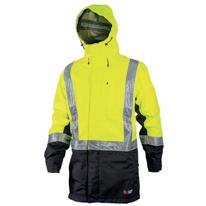
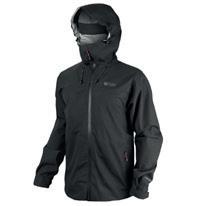
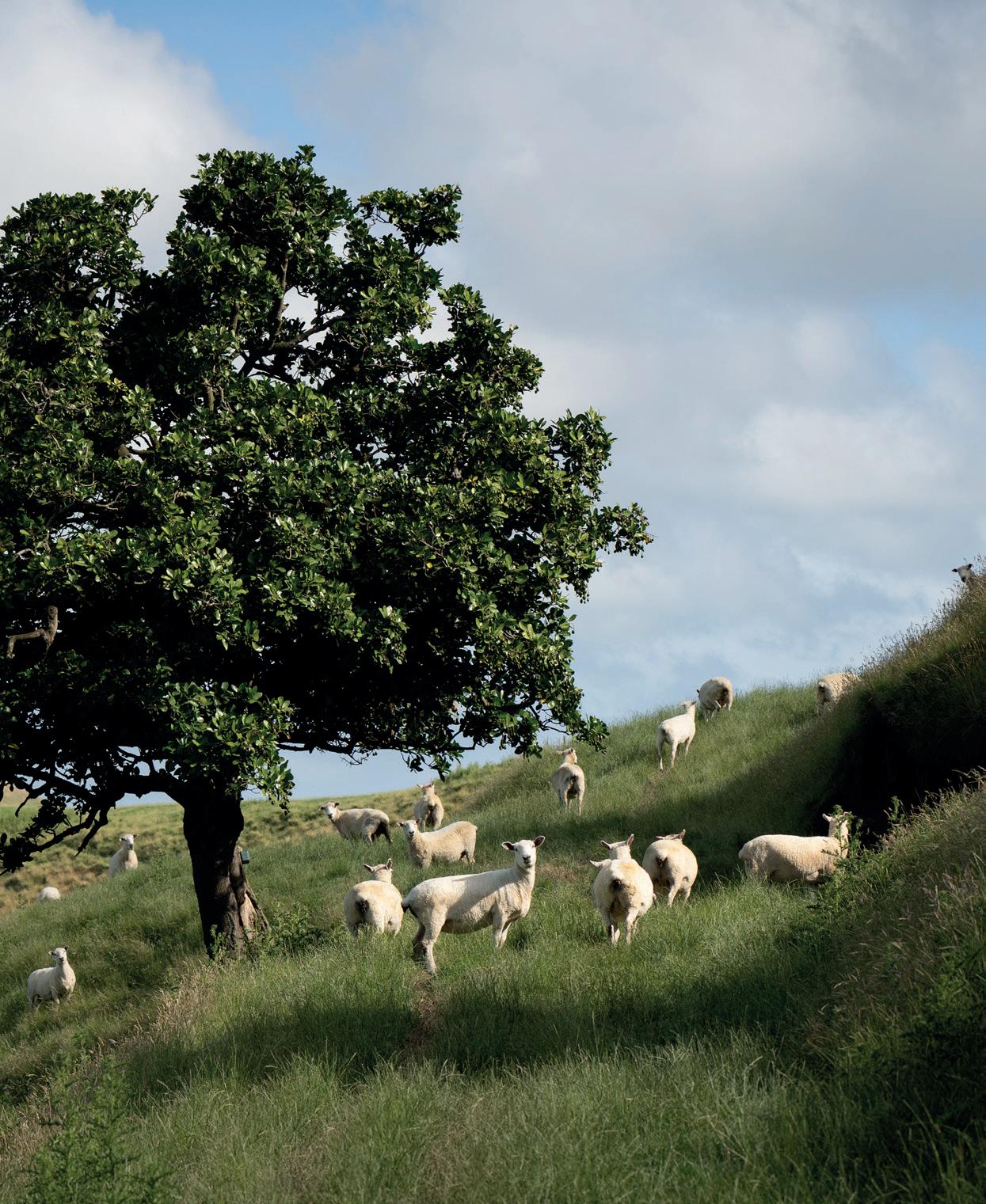
Check out all the Stoney Creek products available for redemption in the farm section

For the farm





For the home
the
to fencing Cookers to couches Surfboards to skydiving
For
lifestyle Fertiliser
Stoney Creek Hi-vis Overtrousers
Stoney Creek Pioneer Jacket
Stoney Creek Pioneer Overtrousers
Stoney Creek Thermotough Jacket
Stoney Creek Hi-vis Jacket
1,404 points 1,862 points 1,237 points 1,862 points 1,945 points 2,569 points If you have suggestions for other products you would like to see on the Advantage website, send us an email at anzcoadvantageprogramme@anzcofoods.com 8 Advantage | June 2024
Stoney Creek Chief Jacket



5 2 6 7 Dyson Hot and Cool Purifying


11




4
Stoney Creek Thermotough Vest – Mens and Womens
1 1,529 points






Rata Creek Throw Samsung TV –The Frame Garmin Epix Gen2 SP Black Titanium
from
2,480
1,436
10,969 points 3,842 points 580 points 1,704
958 points 6,816
Saben Roma Carry All Bag Hutchwilco Safety Grab Bag Moemoe 100% Wool 2-in-1 Duvet Combo NZ Pinot Noir Tour Wines Breville the Barista, Pro Coffee Machine
11,676 points
points
points
points
points
Fan Heater 5,227 points 3
2,143
472
Check out your points balance if you haven't already and see what you can redeem. Winter warmers, family escapes, special treats and the latest technology plus much more! www.anzcoadvantage.com Got points to use? Get shopping!
8 10 13 12 9 Nikon Prostaff 5 Binoculars Eltom Distillery Sigma Rum Shark FlexStyle Air Styler and Dryer
points
points
9 ADVANTAGE REWARDS
Global market update
Global market dynamics continue to provide challenges for New Zealand beef and lamb exporters. When it comes to looking at the current state of global markets for beef and lamb, it is important to consider the impact of consumption and supply dynamics on demand for our product.
CONSUMPTION
Consumption is weak across all our major markets.
Poor consumer confidence is leading to end-users trading down to get the most value for their money, which means less ribeye and more ground beef being purchased in supermarkets and fewer frenched racks and more hamburgers being bought in restaurants.
It feels like there is still some way to go before we see a meaningful turnround. Even though in many countries unemployment is low, inflation rates are trending in the right direction and interest rates are on the verge of retreat, most consumers are more interested in where they were financially three or four years ago rather than last quarter or 12 months prior. Most feel considerably worse off, with the cost-of-living increases seen during recent years now ‘baked in’. The prevailing geopolitical environment is only adding to the uncertainty consumers are dealing with.
SUPPLY
Regarding global supply, there are several factors in play that offer a mix of downside and upside risk .
"As New Zealand’s largest export market, it is often overlooked that China’s own sheepmeat industry is huge. "

During the past six months one of the downsides has been an increase in supply of lamb out of Australia. Liquidation of the Australian flock has seen a flood of product hit key sheepmeat markets such as China, the US and UK, and that has increased the level of competition and adversely impacted prices. Thankfully the Australian situation appears to be largely back in balance, and it is hoped that its impact on our lamb markets will be marginal in the second half of 2024.
CHINA
Another downside risk is the increasing supply of sheepmeat within China, New Zealand’s largest export market.
It is often overlooked that China’s own sheepmeat industry is huge. Over 5mMT of domestic product is consumed within China each year, versus about 400,000MT of imports, predominately from New Zealand and Australia, thus a 5% increase in domestic supply means an additional 250,000MT of product entering the market – which equates to about 60% of the current opportunity for imported product. The majority of sheepmeat we sell into China is a mix of low-end products such as bones, offal and flaps. In that sort of commodity market any value proposition we may claim as an industry very quickly becomes irrelevant. Growth in Chinese production, driven by an increase in government support, improving genetics, more modern farming practices, and a trend towards grain-based systems that increase yields, has the potential to have an impact on the long-term demand for New Zealand sheepmeat to China. Arguably that impact is already in play and will slow down any eventual recovery in demand and pricing.
MARKET UPDATE 10 Advantage | June 2024
EUROPE & UK
Conversely, we have seen strong customer interest for our lamb in Europe and UK this year and a gradual increase in pricing for high-value products such as legs, loins and racks.
This has been driven by a supply shortage of UK lamb that has seen livestock prices breach £9/kg (about NZ$18/kg). UK processors are in turn limiting their domestic lamb kill to minimise their exposure to such highpriced raw material and customers have increasingly turned to New Zealand to provide a cost-competitive alternative. Unfortunately, it is likely that this situation will moderate as new season lamb in the UK begins to hit the market during the next three months, so our window of opportunity to capture increased value may be short-lived, but it is becoming the view of many of our customers that the current challenges in the UK industry are systemic and similar supply gaps will consistently become an issue moving forward. This is leading to conversations around their risk mitigation strategies and how we might assist. That can only be positive for the future of our lamb business in this part of our sales network.
USA
The last and most significant supply factor in play right now is the shortage of domestic beef in the US.
Prices have firmed for imported manufacturing trim and prime cuts in the first few months of 2024 and the long-term trend looks positive given the significant effort that will be required to rebuild the domestic industry. A firming market for beef in the US will no doubt increase competitive tension in other parts of the world too. It is certainly hoped that the old saying ‘a rising tide lifts all ships’ will be relevant when it comes to global beef markets.
DEMAND
Bringing supply and consumption together,

demand for New Zealand beef and lamb has been steady over the first few months of 2024. We are still finding markets for our product, however the generally weak consumption trends mean that prices have struggled to lift – we need consumption to drive demand and value for our products long term. In the short to medium-term, demand and price is being driven by supply, and the current supply outlook for beef is likely to provide a welcome boost to our business and to our farmers around New Zealand. Unfortunately, the outlook for lamb demand and value, driven again predominately by prevailing supply dynamics, is far less certain.
FINDING A BALANCE BETWEEN SHORT- AND LONG-TERM THINKING
In the same way we assess market dynamics in both short and long-term horizons, one of the fundamentals of successful brand development is also about striking the balance between short-term and long-term thinking.
ANGEL BAY BRAND
ANZCO Foods’ work on the Angel Bay brand, which has been a real success story in New Zealand and Australia, is a great example of this.
Initiatives such as our limited time Smoky Barbeque patty, which is now available across New Zealand supermarkets and is championed by one of New Zealand’s greatest Olympians, Dame Lisa Carrington, provide real energy to the brand and can stimulate a boost in sales right across our Angel Bay range. Meanwhile, underpinning such projects is an even more important and consistent brand-building campaign that focuses on slowly building consumer awareness and appreciation of Angel Bay’s quality, convenience and ‘every day deliciousness’ year after year.
ANZCO FOODS IRONMAN® NEW ZEALAND
Another example is how we are trying to build awareness of the ANZCO Foods' story in New Zealand.
Our partnership with IRONMAN New Zealand provides a great opportunity to increase our profile around this iconic event each March. Behind that initiative, there is an increasing body of work that ensures we are consistent in our messaging around what we do as a company long term, which is to deliver nutrition and good health from New Zealand’s finest beef and lamb.
11
NEW PRODUCT DEVELOPMENT (NPD)
Managing new product development within ANZCO Foods is also part of the sales and marketing team’s function.
Here too, we are constantly managing the balance between shortterm and long-term thinking. It is important to have a well-managed list of projects in the short to medium term. This might include a new product launch or an innovative packaging change. Long-term NPD can be more challenging to develop. The focus on this horizon often includes investigating and understanding new and emerging technologies that could make our processing plants more efficient and productive. Such technologies may also be focused on meeting a potential need within our global customer base that can help strengthen our commercial relationship through the solutions we are offering.
The starting point for developing a long-term NPD plan is understanding the emerging trends that will impact our sector, our customers, and our consumers around the world.
ENVIRONMENTAL FOOTPRINT
One such trend is linked to the environmental sustainability of our industry.
This is a topic that leads to strongly held beliefs on both sides of the debate. The reality is, at least from my perspective, that there is no right or wrong answer when it comes to how best to manage this trend. It ultimately comes down to how each individual company or farmer determines where they are comfortable sitting within the spectrum of views.
ANZCO Foods is committed to a journey that will see us improve the way our processing plants manage our environmental footprint now and into the future. We have invested significantly during recent years to
better manage our emissions and that commitment will continue in the years ahead. We know that in the long term what we are doing makes sense, but the immediate benefits of those investments can often be hard to quantify from a sales and marketing perspective.
Often the message we hear is that our industry’s global customers are demanding us to do more and that our consumers are willing to pay more for products that are environmentally sustainable. However, based on our engagement with customers and consumers, there are still significant gaps between the theory and reality. We have yet to see real proof that a material group of consumers across multiple markets are willing to put their hands in their pockets when push comes to shove. That then flows back through the value chain, meaning no one is willing to take on the financial burden. Despite these short-term challenges, this trend will grow in importance over time and will evolve to a point that does provide the necessary clarity on what the best way forward will be for farmers, processors, customers and consumers.
As an industry it is therefore important that we are unified in terms of what we are trying to achieve and how we should go about achieving it. That's why ANZCO Foods is a big supporter of NZFAP Plus.
NZFAP PLUS
Once again, there are the shortand long-term implications to consider related to NZFAP Plus. In the short term, the financial benefit to processors and farmers who have chosen to be the early adopters of NZFAP Plus may be difficult to quantify. Long term, having ANZCO Foods' suppliers working under the NZFAP Plus programme has the potential to be of real value to both our business and our farmers. This will come from capturing additional value from specific customers who are
"ANZCO Foods is committed to a journey that will see us improve the way our processing plants manage our environmental footprint now and into the future."
committed to their own sustainability journey – particularly as their deadlines to achieve certain goals slowly but surely catch up with them.
Perhaps even more importantly, NZFAP Plus can provide an important way of protecting the world-class market access that we have historically enjoyed, as well as ensuring that we can retain the unique value proposition that New Zealand beef and lamb lays claim to. This value proposition – based on our environmental performance, our pasture-based farming systems and the nutrition and good health that our grass-fed products deliver – can only be supported by brands and marketing up to a certain level. In a world demanding greater transparency and traceability, it will be verifiable fact-based systems like NZFAP Plus that will be key to building credibility with the new generation of consumers who are more cynical about greenwashing and nebulous product claims. It is this generation of consumers who will shape the long-term future and success of our industry.
 RICK WALKER General Manager Sales and Marketing ANZCO Foods
RICK WALKER General Manager Sales and Marketing ANZCO Foods
MARKET UPDATE 12 Advantage | June 2024
Meet a couple of our Livestock Representatives Each issue we will introduce you to two Livestock Reps
 James Hadley
James Hadley
South Island Livestock Operations Manager
I grew up in Canterbury and have been involved with farming all my life, in sheep and beef.
I have worked in several roles within the agricultural industry with a focus in the last four years on global beef sales and programme development.
The key to my role at ANZCO Foods is managing the flow of livestock into our South Island plants. I work alongside our livestock representatives and their clients to ensure we are supplying the right animals at the right time to meet the current market requirements. It's important that I help the livestock team understand market challenges and changes so they can regularly update our producers.
Like any industry, the key to our success is our people and I'm enjoying getting to know our team and learn about them and what they need to succeed.
I live in Christchurch with my wife Steph and my two young energetic daughters.

William Thompson
Livestock Cadet, North Island
Farming has been a part of my life from a very young age – working every school holidays on my grandparents’ farm, then on large sheep and beef farms. Coming out of high school, I pursued the sport of rowing which took me overseas in New Zealand age group teams. In between rowing training, I would spend time helping on local farms drenching, drafting and carrying out general farm duties.
I am currently part of the ANZCO Foods livestock cadetship, which sees me based in Taranaki while also spending time in other regions with the livestock reps. Being a cadet means I can learn off other reps and understand the different processes across the business from paddock to plate.
Prior to starting with ANZCO Foods in January 2024, I was working on a large-scale sheep and beef farm based 50 minutes out of Taihape. This helped me develop a large range of livestock skills that I can carry through to my current role. Having been a farmer, it is awesome to be working as a cadet and to see these high-quality products coming through at the other end. I look forward to being able to work with farmers to help them get the most out of their business, with the end goal of becoming an established livestock rep.
13 MEET YOUR REPS
New investments to reduce methane emissions
The public-private partnership AgriZeroNZ recently made three new investments to fasttrack emissions reduction tools for Kiwi farmers.
To date, the joint venture (JV) has committed more than $29m to accelerate development of emissions reduction tools for pasture-based farms, including funding for a methane inhibiting bolus, novel probiotics, New Zealand research for a methane vaccine and inhibitor, and construction of a greenhouse gas testing facility.
LOW EMISSIONS PASTURE
AgriZeroNZ is investing up to $5m in BioLumic, an agri-tech company using ultraviolet (UV) light to develop a low emissions farm pasture with increased productivity gains.
BioLumic, founded in New Zealand with offices in Palmerston North and the United States, is internationally recognised for its use of UV light to boost plant performance.
AgriZeroNZ’s investment will enable BioLumic to apply its technology to ryegrass, with the goal of increasing fat content and subsequently reduce methane emissions from animals that consume it.
Studies have found that a 1% increase in lipids (fat) content of feed will reduce methane emissions by about 5%. BioLumic is targeting a 2–3% increase in the lipids content of ryegrass to drive methane reduction by more than 12%.
The company has achieved promising results on ryegrass to date.
NEW VACCINE VENTURE
In April, Minister for Agriculture Todd McClay announced a new methane vaccine venture with AgriZeroNZ
This rolls more than 15 years of pioneering research into one entity, to support a stronger focus on vaccine development and attract international funding to help deliver a world-first solution to market.
This follows AgriZeroNZ's earlier commitment of up to $1.5m into the methane vaccine development programme while it explored ways to accelerate it.
A methane vaccine is highly sought-after as a low cost, highimpact solution to reduce agricultural emissions and Kiwi scientists have done some ground-breaking work in this space over the years. The new venture aims to significantly boost their work and help get the vaccine into farmers’ hands sooner.
AgriZeroNZ is investing an additional $1m to set up the new venture that will operate as a standalone entity but continue to be co-funded by the AgriZeroNZ JV.
A SECOND VACCINE INVESTMENT
In May AgriZeroNZ announced a further investment of $9.9m to accelerate US company ArkeaBio’s development of a methane vaccine for ruminant animals,
with an initial focus on cattle.
The JV is backing two vaccine projects to increase the chance of delivering the highly sought-after, world-first solution.
A methane vaccine for ruminant animals is internationally recognised as the ‘holy grail’ to deliver methane reduction at low cost and mass scale. It could be one of the best long-term options to really shift the dial on agricultural emissions in New Zealand without compromising farm profitability, as well as a powerful tool globally.
ArkeaBio is based in Boston and is led by Kiwi expat Colin South. The start-up is developing a safe, user-friendly, and cost-conscious vaccine to reduce ruminant methane emissions that will work seamlessly with existing global agribusiness practices. With a record of success and a growing reputation in the industry, ArkeaBio has emerged as a leading player known for its ground-breaking research, cuttingedge solutions, and commitment to changing the sustainable agricultural landscape as we know it.
A vaccine is a critical tool to help farmers achieve AgriZeroNZ’s ambition of reducing agricultural emissions by 30% by 2030, which is crucial for New Zealand to meet global customer targets, protect trade agreements and support the country's climate goals.
14 Advantage | June 2024 SUSTAINABILITY
AGRIZERONZ GROWS WITH NEW PARTNERS
The a2 Milk Company, ANZ Bank New Zealand and ASB Bank have joined AgriZeroNZ, with efforts to equip Kiwi farmers with tools to reduce emissions.
AgriZeroNZ is a world-first publicprivate joint venture (JV) focused on helping farmers cut emissions while maintaining their competitive edge.
The JV was established in February 2023, by the New Zealand Government through the Ministry for Primary Industries and private sector companies – ANZCO Foods, Fonterra, Rabobank, Ravensdown, Silver Fern Farms and Synlait.
The new shareholders bolster the AgriZeroNZ fund by $18m, with
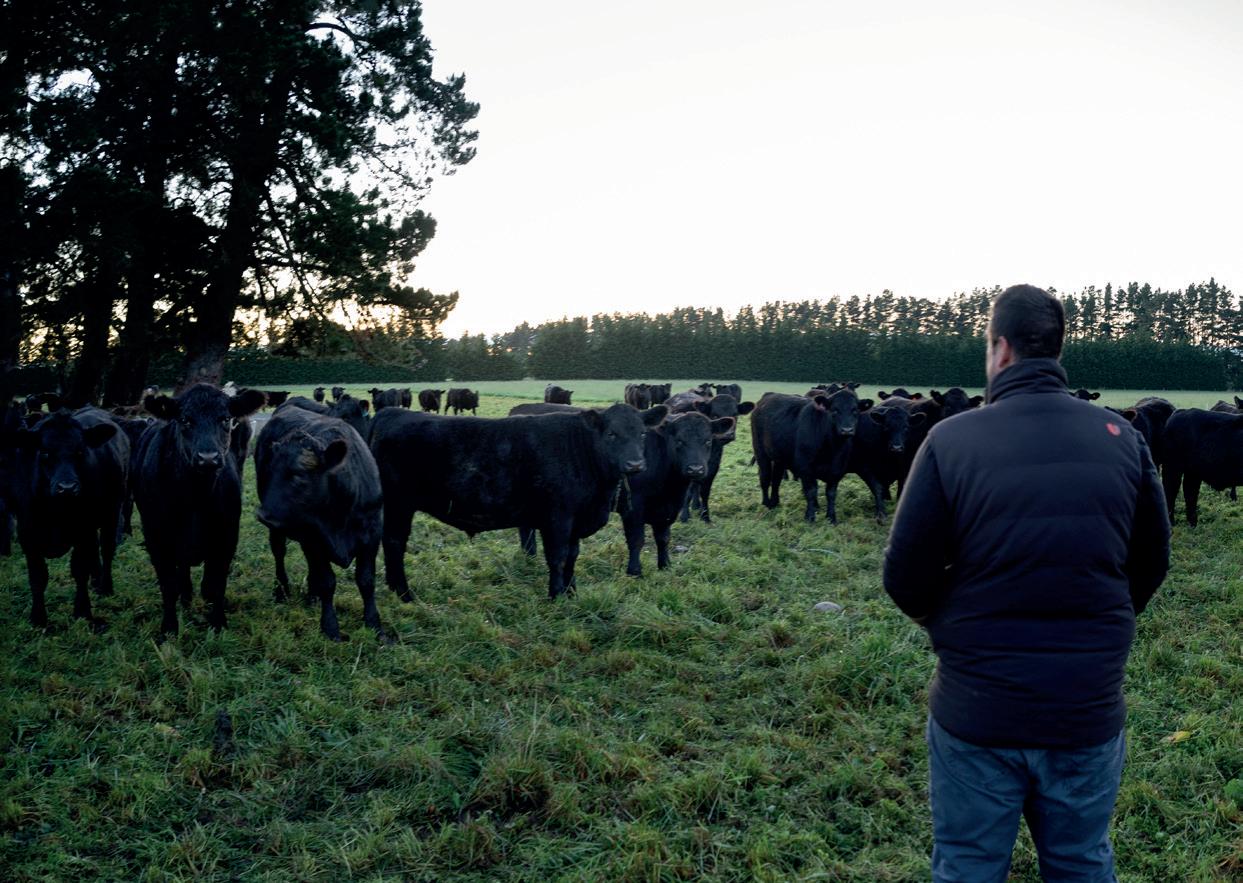
private sector funding being matched by Government, dollar-for-dollar. This takes AgriZeroNZ’s total funds to $183m for its first four years.
The JV’s ambition is to accelerate development of tools and technology to provide New Zealand farmers with access to affordable, effective solutions to reduce biogenic methane and nitrous oxides emissions, with a goal of supporting a 30% reduction by 2030 and drive towards ‘near zero’ by 2040.
AgriZeroNZ is part of the Government’s Centre for Climate Action on Agricultural Emissions alongside the New Zealand Agricultural Greenhouse Gas Research Centre, established in 2009.






FUNDS TO DATE Q3 FY24 SHAREHOLDERS INVESTMENT HIGHLIGHTS EMISSIONS GOALS INVESTMENTS TO DATE 10 PROJECTED TIMELINE 2023 2040 2030 Ruminant Biotech $1.8m Research & Trials* $3.2m New Greenhouse Gas Testing Facility $4m Hoofprint Biome $4.2m ArkeaBio UPDATED $9.9m NZ methane vaccine venture setup NEW $1m BioLumic NEW $5m ON OUR RADAR 77 TOTAL FUNDS TO 2026: $ 165m Units expressed in metric tonnes of CO2 equivalents Data source: NZ Greenhouse Gas Inventory 1990–2021 Emissions (000s) 31 March 2024 Total: $43.5m Part of the Centre for Climate Action on Agricultural Emissions alongside the New Zealand Agricultural Greenhouse Gas Research Centre (NZAGRC). Scorecard WHO WE ARE A public-private partnership between major New Zealand agribusinesses and Government WHY WE EXIST To ensure all farmers have equitable access to solutions to reduce their emissions, supporting a 30% reduction by 2030 and ‘near zero’ by 2040 HOW WE’RE DOING IT Accelerating development of tools and technology through targeted investments Shareholders contribute to our fund each year. Industry funding is matched by Government, dollar-for-dollar. New shareholders can join and grow the fund. 50% Government 50% Industry Ramping up investments Research and commercialisation 2-3 tools in widespread use $9.7m Available $4.6m OPEX $29.2m Allocated *Includes multiple projects We are here 30 20 10 0 2017 Baseline 2021 Latest data 29.6 7.4 29.4 7.4 20.72 5.18 Methane (CH4) Nitrous oxide (N2O) 2030 Ambition

The latest from ANZCO Foods
We've been busy over the past few months connecting, sharing and learning, here in New Zealand and around the world.

CELEBRATING 40 YEARS OF ANZCO FOODS
In April we celebrated 40 years since ANZCO Foods was founded in 1984.
This significant milestone is only possible due to the hard work, dedication and support from everyone who has played a role in getting ANZCO Foods to where we are today.
Here’s to 40 great years, and many more ahead of us.
WĀNAKA A&P SHOW
The ANZCO Foods’ team recently attended the Wānaka A&P show, one of the South Island’s largest
and most popular agricultural and pastoral shows.
The team cooked up delicious ANZCO Foods' beef and lamb for attendees to try. Our ANZCO Foods' site featured a variety of games and activities which enabled visitors to learn about the ANZCO Foods brand in a fun and engaging way.
It was a great opportunity to keep sharing our nutrition and good health message, continuing from ANZCO Foods' IRONMAN the week prior.
Some of our livestock reps also headed along and took the opportunity to meet farmers from the region.
PRIORY VOTE OF THANKS FROM HATO HONE ST JOHN
ANZCO Foods was awarded a Priory Vote of Thanks in recognition of the exceptional contribution made to the work of Hato Hone St John in New Zealand.
This prestigious accolade has been awarded by St John’s Prior, Her Excellency The Right Honourable Dame Cindy Kiro, Governor General of New Zealand on the recommendation of the Order of St John New Zealand Priory Chapter.
The Priory Vote of Thanks was awarded after significant fundraising efforts saw ANZCO Foods donate
1 2 16 Advantage | June 2024 RECENT EVENTS
Congratulations to ANZCO Foods’ suppliers, Simon and Josi Beamish, and Hugo and Pip Beamish from Awapai farm, for receiving the East Coast Regional Supreme Winner award in the 2024 Ballance Farm Awards.
a brand-new ambulance to the St John fleet in August 2020, as well as ongoing running costs of the ambulance in 2021, 2022 and 2023.
There was also a donation of $35k made to St John following sales of our Limited Time Jamaican Jerk Angel Bay patty sales back in 2022.
INTRODUCING WASTEWATER GEOTUBES AT ANZCO FOODS CANTERBURY
During ANZCO Foods Canterbury’s shutdown last year, a dredge and sludge dewatering facility was established at the site to help maintain biological activity in the site’s effluent pond.
This sustainable technology has been a success, with positive outcomes for the site and community, and the technology is now being installed at ANZCO Foods Eltham.
CLIMATE
CHANGE AND SUSTAINABILITY REPORT
Our latest Climate Change and Sustainability report is available on our website in a digital book format and in a PDF.
A lot happened in this space in the last year, including a new 1MW high temperature heat pump and 2MW boiler installed at ANZCO Foods Kōkiri, and a successful cardboard and plastic recycling programme at ANZCO Foods Waitara. We’ve diverted 87% of our waste across all sites, which brings us closer to our goal of diverting 90% of our waste by 2030. You can read about these initiatives and more in the report.
BALLANCE AWARD WINNERS
Congratulations to ANZCO Foods’ suppliers, Simon and Josi Beamish,
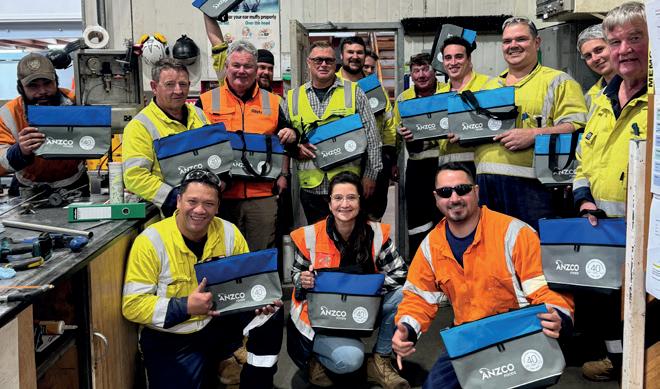

and Hugo and Pip Beamish from Awapai farm, for receiving the East Coast Regional Supreme Winner award in the 2024 Ballance Farm Awards. They also received four other awards.
Awapai has supplied us with beef and lamb for five years and joined the NZFAP Plus programme in 2022. They are currently working towards their NZFAP Plus accreditation with AgriIntel.
1. Our ANZCO Foods Ironman race crew. 2. Receiving the Priory Vote of Thanks award from Hato Hone St John.
3. Celebrating 40 years at ANZCO Foods Canterbury.
4. ANZCO Foods Climate Change & Sustainability report. 5. Wastewater geotubes.
ANZCO FOODS IRONMAN RESULTS
The ANZCO Foods IRONMAN event took place on Saturday 2 March in Taupō.
Congratulations to everyone who participated; Pete Conley, Rick Walker, Emma Waite, Becky Turnbull, Louisa Hurst, Lucy Gunn, Hayley Behrns, and Cherie Richardson. Our external competition winners, Nicky Caird and Jordan Milner, also did exceptionally well.
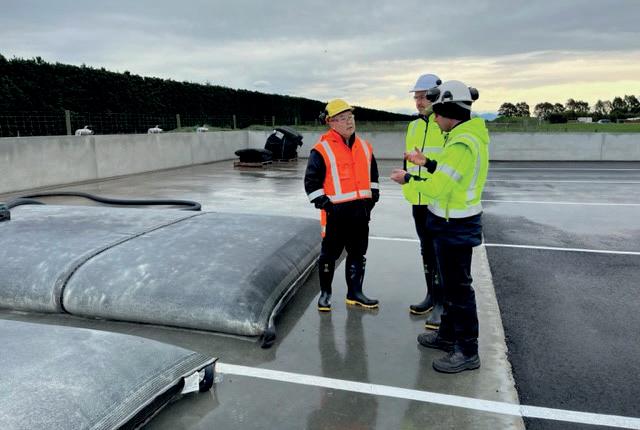
3
5 17
4
with New Zealand’s finest beef and lamb

Endurance, Resilience and Life-Balance
Marlborough-based sheep and beef farmer and ANZCO Foods' supplier Kieran Hickman talks about balancing life with his new passion for IRONMAN®, the mental and physical challenges of adventure racing, and the value of great nutrition.
Kieran, tell us how you came to represent ANZCO Foods at IRONMAN New Zealand.
It all started back in 2022 when I was in the middle of the spring lamb draft. My stock agent, who knew I’d done a bit of adventure racing, mentioned a competition that ANZCO Foods was holding to find amateur athletes keen to give IRONMAN New Zealand a crack. I entered and was lucky enough to be selected.
What were the biggest challenges you faced preparing for that first race?
The main issue was the swim, which is why I ended up choosing to do the shorter 70.3 event (with a 1.9km swim, compared to the full IRONMAN distance of nearly 4km). While I knew how to swim, I’d certainly never done anything competitive in the past, so I needed to put in a bit of work there. Time in the water was the key – I just needed to get used to swimming for longer distances. Every time I took my daughter to her swimming lesson I’d
jump in the pool and do some lengths. It ended up turning into one of the real positives from the whole experience. I’m certainly never going to be an elite swimmer, but I’m now much more comfortable in the water.
And how was the race-day experience for you?
It was very challenging but also really rewarding. I loved racing under the ANZCO Foods' banner. They had several ANZCO Foods' staff members competing, and we got to rub shoulders with elite athletes such as ANZCO Foods' brand ambassadors Braden Currie and Hannah Berry. I finished in about six hours, which I was happy with.
We understand you have a bit of a history when it comes to endurance racing. Tell us about your sporting background?
I was a typical Kiwi kid growing up –always active and loved being outside. I played cricket and rugby and was very competitive (probably something
SPONSORSHIP 18 Advantage | June 2024
"It all started back in 2022 when I was in the middle of the spring lamb draft. My stock agent, who knew I’d done a bit of adventure racing, mentioned a competition that ANZCO Foods was holding to find amateur athletes keen to give IRONMAN New Zealand a crack."
to do with having four brothers and two sisters!).
I played semi-professional rugby in Ireland for a couple of years and then got into running once I returned home. That evolved into adventure racing and I have taken part in several of the GODZone races over recent years (where teams of four have to navigate their way across hundreds of kilometres of New Zealand wilderness) as well as the Coast-to-Coast.
What are the key differences between adventure racing and IRONMAN?
The adventure races last for days and there are lots of highs and lows. Everything from the weather to sleep deprivation plays a part, and you also are in a team environment, which adds pressure on yourself to perform. Mentally, you do a lot of growing during those events – you certainly build resilience, and it has helped me deal with some of the things that crop up during daily life, especially being a farmer with all the challenges that can present. ANZCO Foods IRONMAN New Zealand, on the other hand, is a very individual race and the intensity is much higher – you’re trying to stay just under your lactic threshold the whole time.
You got the IRONMAN bug and went back in 2024, tell us about that.
I have certainly been bitten by the IRONMAN bug. My next goal was to complete the full distance at the first ANZCO Foods title partner IRONMAN New Zealand, which was another experience in itself. I got it done, but never again I told myself, however I have just signed up to join the ANZCO Crew for 2025, my goal is to crack sub 12 hours.
How do you juggle all the necessary training with fatherhood and life on the farm?
Well, there are certainly some early mornings and late-night training sessions to keep on top of things! I have a pretty busy life – I’m on the local school board, I’m a member of the rural fire brigade, the coach of several kids’ sports teams, as well as running the farm. But family always comes first. After that, it’s just about prioritising and planning. When I’ve got a big event on the horizon like ANZCO Foods IRONMAN New Zealand I try to do everything I can to get ahead on the farm before the training volume starts to ramp up. That hopefully saves me some time down the track and gives me a few more opportunities to get those training sessions in.
And what role does nutrition play in all of that?
It’s super important! I completed a Diploma in Exercise, Sport and Nutrition at Canterbury University, so I’ve always been aware of the role nutrition plays in achieving your best performance. As a member of the ANZCO Foods' crew I was lucky enough to get some time with Mikki Willenden, a registered nutritionist and leader in the health and wellness space. She gave me some great tips, notably to increase the amount of protein I was taking on board during my lead up to March.
As a family, we always eat together, and always try to eat as ‘clean’ as possible. We limit the processed stuff and focus on whole foods. ANZCO Foods' lamb racks with mint sauce are a family favourite. Having said that, I do find it hard to pass up a good ribeye steak, cooked rare on the BBQ and accompanied by garlic sauce!
What’s it been like being a livestock supplier to ANZCO Foods?
We supply both cattle and lamb to ANZCO Foods, and it’s a partnership
we feel very privileged to have. They have been incredibly supportive and foster a real sense of family amongst their suppliers. Their support of IRONMAN New Zealand is amazing too – they pour so much effort and time into the event and they are truly passionate about spreading the nutrition and good-health message to all New Zealanders.
Finally, what advice do you have for other farmers out there who may be interested in competing in an IRONMAN?
It’s usually the swim that puts people off and is the biggest challenge, so putting a little more training in the water would useful, but being out there on the course and being part of the ANZCO crew is a pretty amazing experience, so put the work in and give it a crack.

19
Supporting our communities

SPONSOR A SCHOOL DONATIONS
The ANZCO Foods Sponsor a School programme donations for 2023 have been given to participating schools, and we're pleased to report that more than $109,000 has been donated to rural schools in our regions.
The funds will be spent on a variety of resources for students, including fruit and vegetable plants for St Joseph’s School Ōpunake in Taranaki, and supporting teacher aides for additional literacy lessons for Canterbury’s Mayfield School.
Dairy farmers who supply us can nominate a rural school to receive donations, linked to their supply.
SURFING FOR FARMERS
The Surfing for Farmers season has wrapped up for the year, with farmers meeting up once a week throughout summer to surf, chat and relax.
ANZCO Foods is proud to support Surfing for Farmers in Opunake, Taranaki, Central Hawke's Bay, Gore Bay, Sumner, Hickory Bay and Dunedin.
We've loved hearing the stories coming out of these sessions and look forward to the next season starting!
surfingforfarmers.com
2.
CANTERBURY WEST COAST AIR RESCUE TRUST UPDATE
ANZCO Foods is a proud partner of the Canterbury West Coast Air Rescue Trust, which operates the Westpac Rescue Helicopter and Flying Doctor Service.
In 2023 they ran a total of 991 missions across the Canterbury and West Coast regions – that’s about 19 missions a week!
RANGITIKEI SHEARING SPORTS ANNUAL SHEARING COMPETITION
The 60th anniversary of the Rangitikei Shearing Sports Championship was held in February.
Winner Laura Bradley is the first female to win the senior shearing champion in the 60 year history of the competition.
This competition, which ANZCO Foods has supported for many years, attracts more than 170 competitors annually, each showcasing their skill across five competitive grades.
More than 1,100 sheep are shorn during the day.

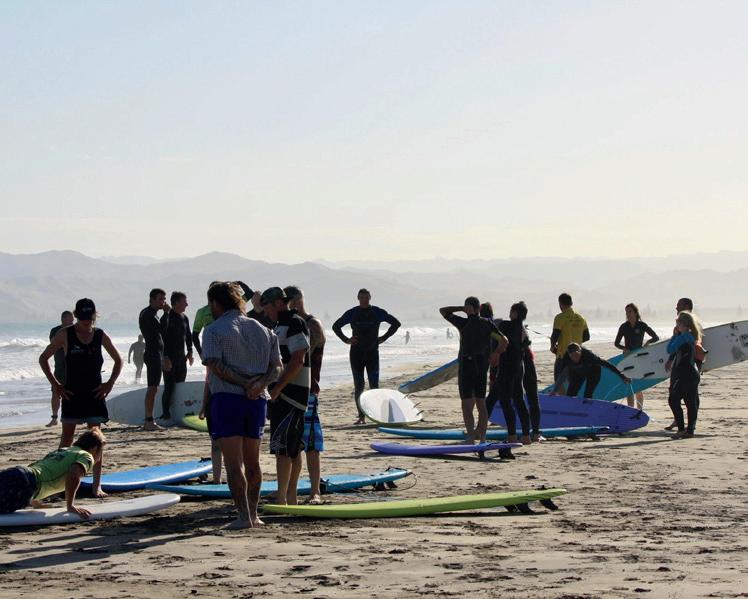 1. St Joseph's School Ōpunake vegetable garden.
1. St Joseph's School Ōpunake vegetable garden.
1 2 COMMUNITY 20 Advantage | June 2024
Competitors Laura Bradley (left) and Nicki Guttler
Supplying the world's best up-and-coming chefs
Situated in the heart of London, with more than 100 years of history, Westminster Kingsway College (Westkings) has the UK’s leading school of hospitality and culinary arts.
Each year about 260 students graduate from Westkings to take up jobs in the finest hotels and restaurants in the UK.
In 2023 a free trade agreement was signed between NZ and the UK, removing tariffs, and giving duty free access for beef. This provides the UK team with the opportunity to build on the beef business in the UK, leveraging our brands such as Stony River Black Angus and Ocean Beef and reinforcing ANZCO Foods as a reputable supplier of New Zealand beef and lamb.
We are supporting Westkings
by providing students with ANZCO Foods' beef and lamb to create dishes and practice their culinary skills. A few hundred kilos of meat are supplied annually, including ANZCO Foods' premium beef and lamb.
Being a sponsor gives ANZCO Foods exposure and helps raise awareness of our brands and products among the students and existing food service trade.
Ex-students from the college work in some of the finest hotels, restaurants, and kitchens around the world – many as owners or head chefs – so generating awareness and loyalty right at the beginning of their careers is beneficial.
Westkings also provides a mutual ground for both ANZCO Foods UK and potential customers to learn about our products. The UK team recently hosted supermarket customer Aldi for a Wagyu

workshop, sampling our various brands. We look forward to following Westkings students on their culinary journey and working with them to share our message of nutrition and good health with New Zealand’s finest beef and lamb.

Red Meat Sector Conference 2024
Registrations are now open for the Red Meat Sector Conference 2024, the highlight of the red meat sector calendar, which will be held in Wellington at the Takina Convention & Exhibition Centre on 22-23 July.
Brought to you by the Meat Industry Association of New Zealand, in conjunction with partnership sponsor Beef + Lamb New Zealand, this year’s theme is “From our pasture to your plate”.
This sector-wide perspective will showcase expertise and best practice at every step of the sophisticated red meat supply chain that connects our world-leading beef and lamb products to discerning customers around the globe.
More than 400 attendees are expected at this year’s event, representing sheep and beef farmers, red meat processors and marketers, politicians and senior government officials as well as senior leaders from critical support industries such as
shipping, packing, banking, farming supplies and the research and science community. The final touches are being put on an exciting programme, but expect insightful contributions from trade experts, senior politicians, nutrition scientists, marketers, farm leaders and international partners.
More information on the Red Meat Sector Conference 2024 is available from the Conference website: www.redmeatsector.co.nz
There are a range of registration packages on offer, with special pricing available to Beef + Lamb New Zealand registered sheep and beef farmers. Registration details are available here:
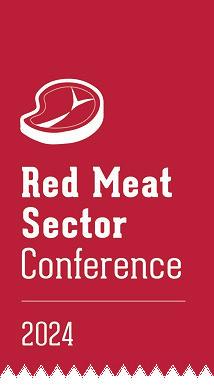

21



SMOKY BEEF & KUMARA BURGER
4 x 120g Angel Bay Smoky Barbeque patties
4 seeded brioche burger buns
4 Tbsp apricot chutney
½ red onion, thinly sliced
4 slices of smoked cheddar
2 cups baby rocket leaves
4 Tbsp aioli
KŪMARA ROSTI
320g orange kūmara, peeled and grated
1 handful fresh parsley or coriander, chopped
1 large egg
½ tsp salt
¼ tsp pepper
2 Tbsp neutral oil

1. Make rosti mixture: place kūmara, herbs, egg, salt and pepper in a bowl and stir to combine well.
2. Cook burger patties according to instructions on packet.
3. While patties cook, fry rosti. Heat half the oil in a large frying pan on medium. Spoon rosti mixture into pan (use of the mixture per rosti) and spread out into a thin round. Fry for 2-3 minutes each side, until golden brown and crispy. Keep warm in oven while you cook remaining rosti, adding more oil as required.
4. Slice burger buns in half and toast.
5. Spread the base of each bun with apricot chutney, then top with red onion slices, burger patties, smoked cheddar, two kūmara rostis and rocket. Spread the top halves of the buns with aioli and sandwich the burgers together.

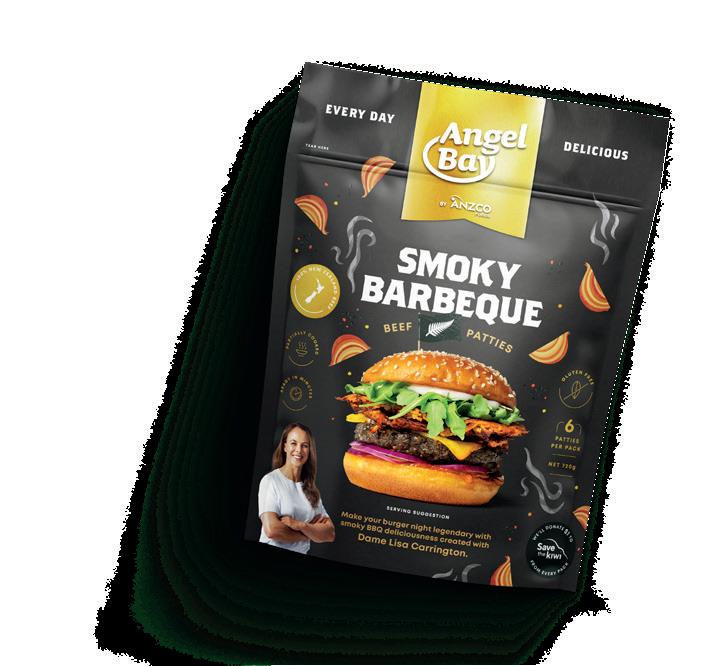
EVERY DAY DELICIOUS.











 GRANT BUNTING
General Manager Systems and Supply, ANZCO Foods
GRANT BUNTING
General Manager Systems and Supply, ANZCO Foods



 Above:
Bluff Station - the high country sheep and beef farm. Right: Hamish and Jess Murray.
Above:
Bluff Station - the high country sheep and beef farm. Right: Hamish and Jess Murray.


































 James Hadley
James Hadley











 1. St Joseph's School Ōpunake vegetable garden.
1. St Joseph's School Ōpunake vegetable garden.








